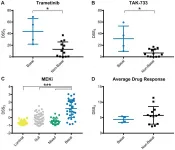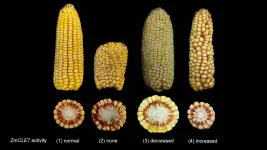(Press-News.org) Establishing a consistent sleep schedule for a toddler can be one of the most challenging aspects of child rearing, but it also may be one of the most important.
Research findings from a team including Lauren Covington, an assistant professor in the University of Delaware School of Nursing, suggest that children with inconsistent sleep schedules have higher body mass index (BMI) percentiles. Their findings, published in the Annals of Behavioral Medicine, suggest sleep could help explain the association between household poverty and BMI.
"We've known for a while that physical activity and diet quality are very strong predictors of weight and BMI," said Covington, the lead author of the article. "I think it's really highlighting that sleep may be playing a bigger role here than it's been given credit for."
The study used data from an obesity prevention trial for mothers and their children living in Baltimore. All of the families were eligible for the Special Supplemental Nutrition Program for Women, Infants, and Children (WIC) and 70% were living at or below the poverty line. As part of the trial, 207 toddlers wore accelerometers that measured their sleep and physical activity for up to a week at a time. Mothers also completed a food diary that was compared with the Healthy Eating Index, a measure of diet quality based on the recommendations from the Dietary Guidelines for Americans.
Researchers wanted to examine the relationship between poverty and BMI, specifically looking at whether the consistency of when toddlers went to bed, their level of physical activity and diet quality could explain the association. They found that children from households with greater poverty had more overall inconsistent sleep onset times. And those with more inconsistent bedtimes had higher BMI percentages.
Covington said it is likely a bidirectional relationship. "There's a lot of teasing out the relationships of the mechanisms that are at play here, which is really difficult to do because I think they're all influencing each other," she said.
Sleep recommendations suggest children go to bed within an hour of their usual bedtime on a nightly basis. But for families living in poverty, such scheduling may not be so easily done, Covington said, especially if a caregiver is the only parent, juggling multiple jobs, parenting multiple children or dealing with a tenuous housing situation.
"There's so many factors that are at play and not necessarily controllable, especially in disadvantaged communities," said Covington, who hopes in the future to develop interventions for families that support healthy routines.
Covington, who joined the UD faculty in 2018, became interested in sleep research while working as a pediatric intensive care nurse. She encountered several families who lost a baby to sudden infant death syndrome (SIDS) as a result of their sleep environment.
"There's so much stigma and stereotypes out there and people are just so quick to judge," she said. "These families just want to do what's right for their child. They just either don't personally know how to or they don't have the resources to do it."
Covington is currently working on a study comparing the sleep similarities between children and their caregivers. She and other researchers, including Associate Professor Freda Patterson from the Department of Behavioral Health and Nutrition, School of Nursing professor Emily Hauenstein and UD graduate students Angeni Cordova and Shannon Mayberry, also completed a systematic review of the existing research literature looking at the influence of the family context in early childhood health sleep health.
Their findings, published in the peer-reviewed journal Sleep Health, found that the presence of household chaos and poor-quality marital relationships were directly associated with early childhood sleep problems and variable sleep timing.
For families who have been struggling during the coronavirus (COVID-19) pandemic, creating a regular evening routine may be a doable way to make a difference in a child's health, despite the other upheaval going on at this time.
"Implementing a consistent bedtime could be one behavioral change that a family could potentially do," said Covington, who came to UD because of the opportunity to work with other sleep and disparity researchers. "It's more attainable than maybe getting healthy food at the grocery store or playing outside on the playground, especially now with the cold weather. Just having a consistent bedtime can help provide some sense of structure, but then maybe have better implications for health and BMI as well."
INFORMATION:
February 22, 2021 - Widely used medications for benign prostatic hyperplasia (BPH) - also known as enlarged prostate - may be associated with a small, but significant increase in the probability of developing heart failure, suggests a study in The Journal of Urology®, Official Journal of the American Urological Association (AUA). The journal is pub lished in the Lippincott portfolio by Wolters Kluwer.
The risk is highest in men taking a type of BPH medication called alpha-blockers (ABs), rather than a different type called 5-alpha reductase inhibitors (5-ARIs), according to the new research by D. Robert Siemens, MD, and ...
Oncotarget recently published in "MEK is a promising target in the basal subtype of bladder cancer" by Merrill, et al. which reported that while many resources exist for the drug screening of bladder cancer cell lines in 2D culture, it is widely recognized that screening in 3D culture is more representative of in vivo response.
To address the need for 3D drug screening of bladder cancer cell lines, the authors screened 17 bladder cancer cell lines using a library of 652 investigational small-molecules and 3 clinically relevant drug combinations in 3D cell culture.
Their goal was to identify compounds and classes of compounds with efficacy in bladder cancer.
Utilizing ...
An international team of scientists, including two from Oregon State University, conducted a biological assessment of the world's rivers and the limited data they found presents a fairly bleak picture.
"For the places that we have data, the situations are not really that good. There are many species that are declining, threatened or endangered," said Bob Hughes, co-author of the paper and a courtesy associate professor in Oregon State's Department of Fisheries and Wildlife. "But for most of the globe, there just is little rigorous data."
The work by Hughes and the ...
By analyzing 50 years' worth of coral reef biodiversity studies, researchers reporting in the journal Current Biology on February 22 have quantified the practice of "parachute science," which happens when international scientists, typically from higher-income countries, conduct field studies in another, typically lower-income country, without engaging with local researchers. They found that institutions from several lower-middle- and upper-middle-income countries with abundant coral reefs produced less research than institutions based in high-income countries with fewer or in some cases no reefs. They also found that host-nation scientists (scientists from the nations where field research was conducted) were ...
Corn--or maize--has changed over thousands of years from weedy plants that make ears with less than a dozen kernels to the cobs packed with hundreds of juicy kernels that we see on farms today. Powerful DNA-editing techniques such as CRISPR can speed up that process. Cold Spring Harbor Laboratory (CSHL) Professor David Jackson and his postdoctoral fellow Lei Liu collaborated with University of Massachusetts Amherst Associate Professor Madelaine Bartlett to use this highly specific technique to tinker with corn kernel numbers. Jackson's lab is one of the first to apply CRISPR to corn's very complex ...
Tracing back a ghostly particle to a shredded star, scientists have uncovered a gigantic cosmic particle accelerator. The subatomic particle, called a neutrino, was hurled towards Earth after the doomed star came too close to the supermassive black hole at the centre of its home galaxy and was ripped apart by the black hole's colossal gravity. It is the first particle that can be traced back to such a 'tidal disruption event' (TDE) and provides evidence that these little understood cosmic catastrophes can be powerful natural particle accelerators, as the team led by DESY scientist Robert Stein reports in the journal Nature Astronomy. The observations also demonstrate the power of exploring the cosmos via ...
A new study from UCLA and Stanford University researchers finds that three-dimensional human stem cell-derived 'mini brain' organoids can mature in a manner that is strikingly similar to human brain development.
For the new study, published in Nature Neuroscience February 22, senior authors Dr. Daniel Geschwind of UCLA and Dr. Sergiu Pasca of Stanford University conducted extensive genetic analysis of organoids that had been grown for up to 20 months in a lab dish. They found that these 3D organoids follow an internal clock that guides their maturation in sync with the timeline of human development.
"This is novel -- Until now, nobody has grown and characterized these organoids for this amount of time, nor shown they will recapitulate human brain development in a laboratory environment ...
A two-metre-long painting of a kangaroo in Western Australia's Kimberley region has been identified as Australia's oldest intact rock painting.
Using the radiocarbon dating of 27 mud wasp nests, collected from over and under 16 similar paintings, a University of Melbourne collaboration has put the painting at 17,500 and 17,100 years old.
"This makes the painting Australia's oldest known in-situ painting," said Postdoctoral Researcher Dr Damien Finch who pioneered the exciting new radiocarbon technique.
"This is a significant find as through these initial estimates, we can understand something of the ...
What The Study Did: Using COVID-19 data, this observational study looked at what are the independent associations of voluntary behavioral change and legal restrictions, such as state-mandated school closings, with the subsequent spread of the COVID-19 pandemic in the U.S.
Authors: Frederick J. Zimmerman, Ph.D., of the Fielding School of Public Health at UCLA in Los Angeles, is the corresponding author.
To access the embargoed study: Visit our For The Media website at this link https://media.jamanetwork.com/
(doi:10.1001/jamapediatrics.2020.6371)
Editor's Note: The article includes ...
A team of scientists has detected the presence of a high-energy neutrino--a particularly elusive particle--in the wake of a star's destruction as it is consumed by a black hole. This discovery, reported in the journal Nature Astronomy, sheds new light on the origins of Ultrahigh Energy Cosmic Rays--the highest energy particles in the Universe.
The work, which included researchers from more than two dozen institutions, including New York University and Germany's DESY research center, focused on neutrinos--subatomic particles that are produced on Earth only in powerful ...





